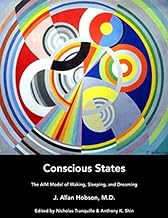 This book advances Dr. Hobson’s AIM (Activation-Input-output gating, Modulation) model of waking, sleeping, and dreaming consciousness. It builds upon Hobson and Robert W. McCarley’s “activation-synthesis” neurophysiological model of dream generation and connects with Karl J. Friston’s model of brain function based on free-energy minimization.-----ForewordConsciousness has been called the last scientific frontier. Neurobiology considers this frontier to have been reached and has begun to study it via the selective analysis of consciousness components. This book uses neurobiology to examine how all of these psychological components are tied together physiologically as the states of waking, sleeping, and dreaming. Having established the scientific validity of identification and differentiation of the physiological states, their psychological features are defined and measured. This establishes the correlation between physiology and psychology. In this book, emphasis is placed upon the correlation of dream psychology with REM sleep physiology compared with the correlation of psychology with the physiology of waking.Because this is a very novel and very preliminary effort, the correlations sought and demonstrated are necessarily formal. This contrasts with the content analytic approach, which has heretofore failed to produce a science of conscious states, and especially a science of dreaming. By formal, I mean, for example, the identification and measurement of such coarse-grained global and universal psychological features of conscious states as sensation, attention, perception, thought, memory, and volition.Once identified and measured, such formal psychological features of any given conscious state can then be mapped onto the measured formal properties of the physiological state with which they are correlated. Based on the goodness of fit of the correlations, the hypothesis of the unity of psychology and physiology may then be considered. In fact, the fit of dream psychology (e.g. bizarreness) and REM sleep physiology (e.g. aminergic demodulation) is so good as to suggest at least a formal isomorphism between the two levels of analysis. The fit is so good as to suggest a causal identity between psychology and physiology.Among the scientific implications of this dual-aspect line of reasoning is the elaboration of a three-dimensional model, called AIM, which illustrates the concept of brain/mind isomorphism and shows how that concept can be used to understand not only the vicissitudes of normal consciousness but also the panoply of unusual and abnormal states such as lucid dreaming, hypnosis, and psychosis. The AIM model is presented as a preview of coming attractions at the hands of mathematically sophisticated consciousness scientists like Karl Friston.The most significant philosophical implication of the dual-aspect monism philosophy elaborated in this book is the reciprocal causality principle. Not only are the psychological and physiological levels of analysis linked phenomenologically, but they are also linked causally: mind is causal upon brain and brain is causal upon mind. This is not surprising if they are one and the same thing and only observed and measured separately. |


